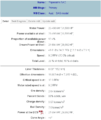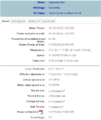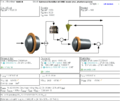Benchmarking: Amelunxen SGI - Agnico Eagle
Contents
Benchmarking: Amelunxen SGI Specific Energy Consumption - Agnico Eagle Laronde
Starkey, J., Robitaille, J., Cousin, P., Jordan, J. and Kosick, G., Design of the Agnico-Eagle Laronde Division SAG mill. Proceedings of SAG 2001, pages III-165 to III-178.
Survey conducted shortly after start-up
Design Criteria
Actual operating data from Esperanza
- A×b of Esperanza ore (Aug-Dec 2012); avg= 39; range is 30.7 to 45.5.
- WiBM average is 16.0 kWh/st, = 17.6 kWh/tonne.
- ESAG for "normal" blasting, average = 5.5 kWh/tonne; range is 3.9 to 7.2 kWh/tonne.
- ESAG for "high intensity" blasting typically 10% lower ESAG.
- SAG feed size range 33.6% to 49.0 percent passing 1¼ inch (32 mm).
Design criteria for expansion cases (which may reflect Esperanza operating conditions)
- SAG circuit F80 = 132 mm
- transfer T80 = 3500 µm (text erroneously says "3500 mm")
- BM circuit P80 = 180 µm
- SAG mill power utilization = 92.3%
- Ball mill power utilization = 95%
- Plant availability = 93%
Mill criteria
- SAG mill: 40 foot nom dia by 26 foot flange-to-flange cylinder length
- ball mill: 27 foot nom dia by 45 foot flange-to-flange cylinder length (2 units)
- SAG mill gearless motor 31,500 HP (given in Thiele & Parraguez, Relpas 2011 conference)
- Ball mill gearless motors 25,000 HP
(some references give 30,000 HP for SAG motor; this is thought to be the value excluding a 5% design margin)
Modelling
The Bond/Barratt SABC-B model is used with the default 10% Essbm calibration factor.
- circuit F80 = 132 mm
- circuit P80 = 180 µm
- The average ball mill work index given as 16 kWh/short ton = 17.6 kWh/tonne
- The relationship between A×b and WiRM for Andean copper porphyries can be used to determine the following rod mill work index values.
- A×b of Esperanza ore; avg= 39; becomes WiRM=14.5 kWh/tonne
- No crushing work index is given. Assume a value of 12 kWh/tonne (slightly higher than typical porphyry)
- No ore density is given. Assume similar to Los Bronces, density=2.64 t/m³
SAG mill is modelled using following:
- Austin model
- assume ore density 2.64 t/m³, same as Los Bronces
- nominal diameter 40 foot, effective grinding length 26 foot (deduct 2 ft from cylinder length)
- assume 6 inch liner effective thickness, mill speed 75% of critical
- ball charge 16% v/v; total filling 26% v/v gives the desired 92.4% utilization of motor power
Ball mill is modelled using following:
- Nordberg wet overflow model
- assume ore density 2.64 t/m³, same as Los Bronces
- nominal diameter 27 foot, effective grinding length 44.5 foot (deduct 6 inches from cylinder length)
- assume 6 inch liner effective thickness, mill speed 75% of critical
- total filling 30% v/v gives the desired 95% utilization of motor power
Results
Only one ball mill work index is provided, claimed to be the 'average'. The predictions of the min/max range are dubious because the ball mill work index should change between hard and soft ore.



